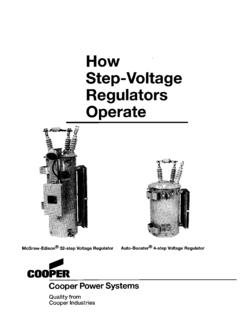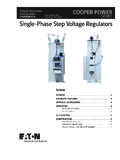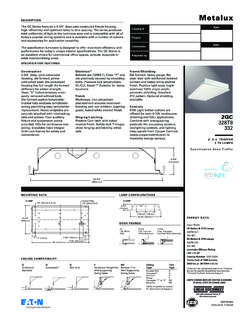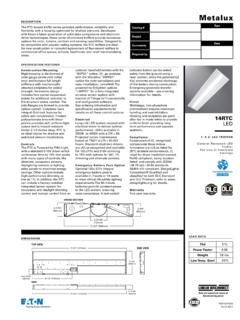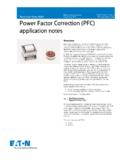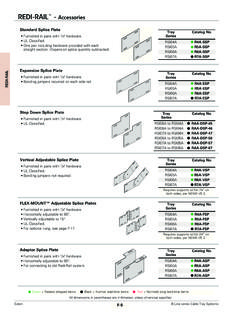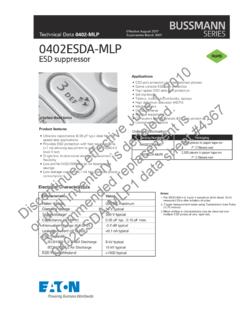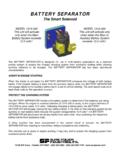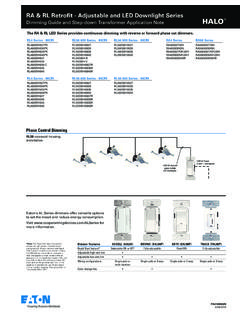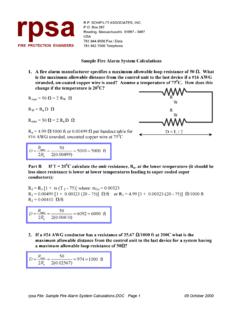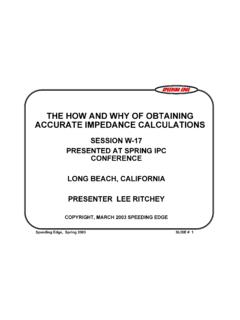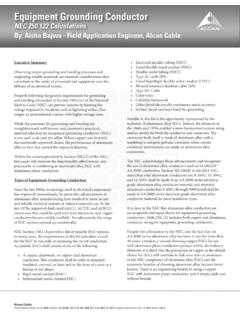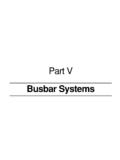Transcription of Voltage Drop Calculations - Cooper Industries
1 199 2005 Cooper BussmannVoltage drop CalculationsRatings of Conductors and Tables to Determine Volt LossWith larger loads on new installations, it is extremely important to consider voltloss in mind, otherwise some very unsatisfactory problems are likely to actual conductor used must also meet the other sizing requirements such asfull-load current, ambient temperature, number in a raceway, to Figure Volt LossMultiply distance (length in feet of one wire) by the current (expressed in amps) by thefigure shown in table for the kind of current and the size of wire to be used, by one overthe number of conductors per , put a decimal point in front of the last 6 digits you have the volt lossto be expected on that 6 AWG copper wire in 180 feet of iron conduit 3 phase,40 amp load at 80% power feet by amperes: 180 x 40 = 7200 Multiply this number by number from table for 6 AWG wire three-phase at 80% power factor.
2 7200 x 745 = 5364000 Multiply by1 5364000 x 1 = 5364000#/phase 1 Place decimal point 6 places to gives volt loss to be expected: (For a 240V circuit the % Voltage drop is x 100 or ).240 These Tables take into consideration reactance on AC circuitsaswell as resistance of the on short runs to check to see that the size and typeof wire indicated has sufficient ampere copper in 180 feet of steel conduit 3 phase, 40 ampIoad at 80% power factor Volt loss from local code equals feet by amperes by 1180 x 40 x1= 7200.
3 #/phase 1 Divide permissible volt loss multiplied by 1,000,000 by this x 1,000,000 = in Conduit, Cable or Raceway per (B)(2)(a)The Number ofPercentage of ValuesConductors In OneIn Tables AndConduit, Cable4 to 680%7 to 970%10 to 2050%21 to 3045%31 to 4040%41 and over35%Conditions Causing Higher Volt LossDirectSingle Or Three Phase Power FactorWire SizeCurrent100%90%80%70%60%14 to 4 to 3/0 5% AWG to 500 kcmil to 1000 kcmil type RHH, THHN or XHHW wire (90 C. wire) is loaded to near its full ratingor if room temperature is 30 C higher than normal, add twice the above per-centages to get the volt Temperature Affects RatingsRoomAmpacity MultiplierTemperatureTWTHW, THWNTHHN, XHHW* C F(60 C Wire)(75 C Wire)(90 C Wire).
4 41 How to Select Size of WireMultiply distance (length in feet of one wire) by the current (expressed inamps), by one over the number of conductors per that figure into the permissible volt lossmultiplied by 1,000, under the column applying to the type of current and power factor for thefigure nearest, but not above your result you have the size of wire number from Table, three-phase at 80% power factor, that is nearestbut not greater than 764. This number is 745 which indicates the size of wireneeded: 6 line to neutral Voltage drop on a 3 phase system, divide the three phasevalue by For line to neutral Voltage drop on a single phase system,divide single phase value by WiringThe volt loss for open wiring installations depends on the separation betweenconductors.
5 The volt loss is approximately equal to that for conductors in non-magnetic conduit. offers a method to calculate conductor in Conduit, Cable or RacewayNEC Tables through give allowable ampacities (current-carrying capacities) for not more than three conductors in a conduit, cable, orraceway. Where the number of conductors exceeds three the allowableampacity of each conductor must be reduced as shown in the following tables:Conditions Causing Higher Volt LossThe Voltage loss is increased when a conductor is operated at a higher temperature because the resistance type RH, RHW, THW, or THWN wire (75 C wire) is loaded to near its full rating, or if room temperature is 15 C higher than normal, add the followingpercentages to get the volt Temperature Affects RatingsThe ampacities (carrying capacities) of conductors are based on a room temperature of 86 F or 30 C.
6 If room temperature is higher, the ampacitiesare reduced by using the following multipliers; (for 0-2000 volt, insulated conductors not more than 3 conductors in raceway or direct buried, ).200 2005 Cooper BussmannVoltage drop CalculationsCopper Conductors Ratings & Volt Loss ConduitWireAmpacityDirectVolt Loss (See explanation prior page.)SizeTypeTypeTypeCurrentThree-Phase Single-PhaseT, TWRH,RHH,(60 Cycle, Lagging Power Factor.)(60 Cycle, Lagging Power Factor.)(60 CTHWN,THHN,100%90%80%70%60%100%90%80%70% 60%Wire)RHW,XHHWTHW(90 C(75 CWire)Wire)
7 Steel1420*20*25*614053694887437138483322 62005643504744443836 Conduit1225*25*30*3860346431692841250821 7240003659328128972508103035*40*24202078 1918172815321334240022141995176915408405 0551528135012641148102690015601460132611 8410406556575982848812745673597980937860 7776904708595616536528491450405620610568 5194683851001104904334344073763415005014 7043439429511513038834635433631228640040 9388361331111013015030827729228026424532 0337324305283012515017024420722822321320 0240263258246232001451751951931731961941 8817820022722421720600016520022515313616 2163160154158187188184178000019523026012 2109136140139136126157162161157250215255 2901039312312812912810814214814914830024 0285320867710811511711790125133135135350 2603103507367981061091097811312212612640 0280335380646091991031047010511411812050 0320380430525081909496589410410911160033 5420475434375848992508697103106750400475 5353436687884884279919710210004555456152 631627278823672849095 Non-1420*20*25*6140536948764355383033016 2005630502944223812 Magnetic1225*25*30*346434643158282724912 15340003647326428772486 Conduit103035*40*24202078190817141516131 624002203198017511520(Lead84050551528135 012551134101088215601449131011661019 Covered655657598284880273165757998092684 5758669 Cables or 4708595616536519479435388620599553502448 Installation 3851001104704334253953613245004904564173 75in Fibre or 2951151303883293303102862593803813583303 00 Other 1110130150308259268255238219300310295275 253 Non-012515017024420722021219918524025424 4230214 Magnetic00145175195193173188183174163200 217211201188 Conduit,00016520022515313315115014513815 4175173167159 Etc.)
8 0000195230260122107127128125121124147148 1451402502152552901039011211411311010412 9132131128300240285320867699103104102881 1411912011835026031035073658994959476103 1081101094002803353806457818789896694100 1031035003203804305246717780825482909394 6003354204754339657276774675838790750400 4755353432586570723867768083100045554561 52625515963663059687377*The overcurrent protection for conductor types marked with an (*) shall not exceed 15 amperes for 14 AWG, 20 amperes for 12 AWG, and 30 amperes for 10 AWG copper ; or 15amperes for 12 AWG and 25 amperes for 10 AWG aluminum and copper -clad aluminum after any correction factors for ambient temperature and number of conductors havebeen applied.
9 Figures are L-L for both single-phase and three-phase. Three-phase figures are average for the 2005 Cooper BussmannVoltage drop CalculationsAluminum Conductors Ratings & Volt Loss ConduitWireAmpacityDirectVolt Loss (See explanation two pages prior.)SizeTypeTypeTypeCurrentThree-Phas eSingle-PhaseT, TWRH,RHH,(60 Cycle, Lagging Power Factor.)(60 Cycle, Lagging Power Factor.)(60 CTHWN,THHN,100%90%80%70%60%100%90%80%70% 60%Wire)RHW,XHHWTHW(90 C(75 CWire)Wire)Steel1220*20*25*6360554250394 5043963341964005819520145773948 Conduit102530*35*40003464316528362502216 5400036543275288925008304045252022512075 1868165614412600239621581912166364050601 6161402131011881061930162015131372122510 7445565751016883840769692613102097088879 9708365758579669266861555749780077171064 4574275901006385545415024584116406255805 2947518510011550643343240537333850049946 8431391010012013540234635333431028440040 7386358328001151351503182772902772602413 2033532030127800013015517525922524123422 1207260279270256239000015018020520017319 4191184174200224221212201250170205230169 1481731731681611722002
